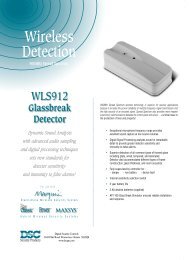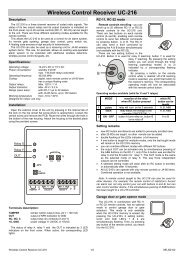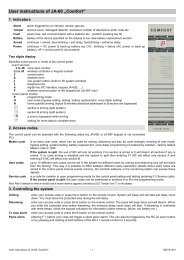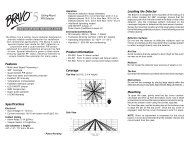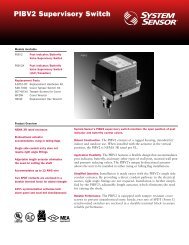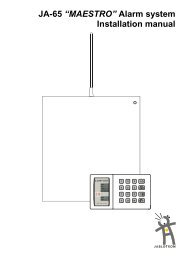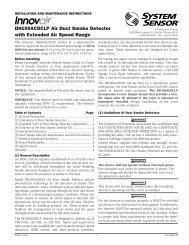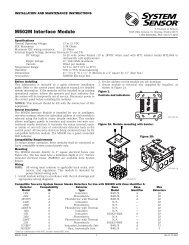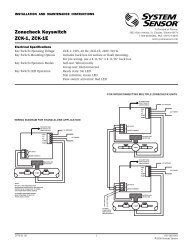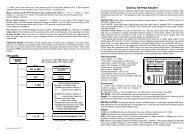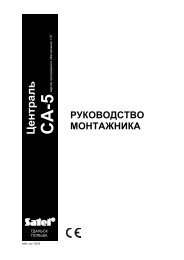I56-1719-000 - 4351E and 5351E Manual.p65 - Cerber.pro
I56-1719-000 - 4351E and 5351E Manual.p65 - Cerber.pro
I56-1719-000 - 4351E and 5351E Manual.p65 - Cerber.pro
You also want an ePaper? Increase the reach of your titles
YUMPU automatically turns print PDFs into web optimized ePapers that Google loves.
CAUTION<br />
Dust covers are fitted to the detectors to help <strong>pro</strong>tect units during shipment <strong>and</strong> when first installed. They are not intended to<br />
<strong>pro</strong>vide complete <strong>pro</strong>tection against contamination; therefore detectors should be removed before beginning construction, major<br />
re-decoration or other dust <strong>pro</strong>ducing activity. Dust covers must be removed before the system can be made operational.<br />
INSTALLATION AND MAINTENANCE INSTRUCTIONS FOR MODELS <strong>5351E</strong><br />
RATE OF RISE AND <strong>4351E</strong> HIGH TEMPERATURE HEAT DETECTORS<br />
Before installing detectors, please thoroughly read System Sensor’s guide for the <strong>pro</strong>per use of system smoke <strong>and</strong> heat detectors, which <strong>pro</strong>vides<br />
detailed information on detector spacing, placement, zoning, wiring, <strong>and</strong> special applications. Copies of this manual are available at no charge<br />
from System Sensor.<br />
GENERAL DESCRIPTION<br />
Model <strong>4351E</strong> <strong>and</strong> 5451E heat detectors use a single thermistor sensing element combined with state of the art electronics to <strong>pro</strong>vide ambient<br />
temperature compensation, <strong>and</strong> fast response. The ability to plug these detectors into a variety of base options extends panel compatibility <strong>and</strong><br />
application flexibility. These detectors are designed to <strong>pro</strong>vide open area <strong>pro</strong>tection <strong>and</strong> to be used with compatible control panels<br />
only.<br />
A bicolour LED on each detector lights red to <strong>pro</strong>vide a local visible alarm indication, <strong>and</strong> may also be set to flash green to indicate correct<br />
operation of the detector. Remote LED annunciator capability is available as an optional<br />
accessory wired to the st<strong>and</strong>ard base terminals. These detectors also have a latching alarm<br />
feature. The alarm can only be reset only by a momentary power interruption.<br />
Figure 1: Base Terminal Wiring<br />
A dedicated tool is available from System Sensor, which may be used to access operating data<br />
SHORTING<br />
from the detector, see the operating manual for the tool for further details.<br />
SPRING<br />
SPECIFICATIONS<br />
V- V-<br />
Height<br />
55mm (mounted in a B401 base)<br />
Diameter<br />
102 mm<br />
2 3<br />
Weight<br />
93g (excluding base)<br />
-<br />
Normal operating temperature range -20°C to 60°C<br />
1<br />
Note: <strong>4351E</strong> Alarm threshold is 78°C<br />
+<br />
4<br />
Supply voltage<br />
8 - 30VDC<br />
5<br />
R<br />
Air velocity<br />
20m/s (4<strong>000</strong> ft/min)<br />
Humidity<br />
5 - 95%RH (non-condensing)<br />
Quiescent current<br />
120µA Typical<br />
Latching alarm<br />
Reset by momentary power interruption. V+ V+<br />
The <strong>5351E</strong> has been independently tested <strong>and</strong> certified to EN54-5: 2<strong>000</strong> Class A1R.<br />
NOTE: WHEN A BASE FITTED WITH A RESISTOR (R) BETWEEN<br />
TERMINALS 4 AND 5 IS USED, THE WIRING SHOULD FOLLOW<br />
The <strong>4351E</strong> has been independently tested <strong>and</strong> certified to EN54-5: 2<strong>000</strong> Class BS.<br />
THE DASHED LINE<br />
A SCHOTTKY DIODE CONNECTED BETWEEN TERMINALS 2<br />
Note: Do not install in locations where the normal ambient temperature range extends AND 3 DOES NOT AFFECT BASE WIRING<br />
beyond 0°C to 50°C for extended periods.<br />
BASE MOUNTING AND WIRING INSTRUCTIONS<br />
Verify that the detector base supplied is compatible with the system control panel.<br />
400 series bases may be mounted to st<strong>and</strong>ard electrical junction boxes with 50-60 mm centre fixings.<br />
See figure 1 for terminal connections on st<strong>and</strong>ard bases. If relay bases are to be used, please refer to the relevant base instructions, <strong>and</strong><br />
packaging.<br />
Note: Series 300 detectors are polarity conscious, <strong>and</strong> must be wired as indicated above.<br />
Note: Do not loop wire under terminals: break the wire run to ensure supervision of connections.<br />
Note: All wiring must conform to applicable local <strong>and</strong> national codes <strong>and</strong> regulations.<br />
Each 400 series base is fitted with a shorting spring, which may be used to connect across terminals 2 <strong>and</strong> 3 to permit loop wiring to be checked<br />
before installation of detector heads. This spring automatically disengages when the detector is fitted into the base.<br />
WARNING<br />
Remove power from detector monitoring circuits before installing detectors.<br />
DETECTOR INSTALLATION<br />
1. Place the detector into the detector base <strong>and</strong> rotate the detector<br />
clockwise with gentle pressure until the detector drops into place.<br />
2. Continue rotating the detector clockwise to lock it in place.<br />
3. After all detectors have been installed, apply power to the detector<br />
monitoring circuits.<br />
4. Test the detector as described under TESTING.<br />
5. Reset the detector at the system control panel.<br />
Tamper-resistance<br />
The detector bases include a feature that, when activated, prevents<br />
removal of the detector without the use of a tool. See figure 2 for details.<br />
Figure 2: Tamper Resist Feature<br />
TO ACTIVATE THE TAMPER RESIST FEATURE, BREAK TAB ON PLASTIC<br />
LEVER AT DOTTED LINE BY TWISTING TOWARD CENTRE OF BASE<br />
TO REMOVE A DETECTOR ONCE THE TAMPER RESIST<br />
FEATURE HAS BEEN ACTIVATED, INSERT A SMALL<br />
SCREWDRIVER INTO THE SLOT IN THE SIDE OF THE BASE<br />
AND APPLY PRESSURE TOWARDS THE BASE WHILST<br />
ROTATING THE DETECTOR IN AN ANTI-CLOCKWISE<br />
DIRECTION.<br />
TESTING<br />
Detectors must be tested after installation <strong>and</strong> following periodic maintenance. However, before testing,<br />
notify the <strong>pro</strong>per authorities that the system is undergoing maintenance <strong>and</strong> the system will be<br />
temporarily out of service. Disable the zone or system undergoing maintenance to prevent unwanted<br />
alarms.<br />
Test the detector as follows:<br />
Direct Heat Method<br />
1. Use either a specialised tool such as supplied by No Climb Products Limited, or a hairdryer of<br />
1<strong>000</strong> to 1500 Watts.<br />
2. Direct the heat towards the sensor thermistor from it’s side. Hold the heat source about 15cm<br />
away from the detector to prevent damage during the test.<br />
3. The red LED on the detector should latch into alarm within 30 seconds, <strong>and</strong> the control panel<br />
should activate into alarm.<br />
Laser test tool method (model no. S300RTU)<br />
Note: this method does not carry out a complete functional test of the detector.<br />
1. Align the flashing red spot <strong>pro</strong>duced by the laser beam with the led on the detector.<br />
2. The red LED on the detector should latch into alarm within a few seconds, <strong>and</strong> the control panel<br />
should activate into alarm.<br />
CAUTION<br />
The S300RTU test tool is a Class II laser <strong>pro</strong>duct.<br />
Do not direct the beam towards a person’s face or eyes, as eye damage may occur<br />
Figure 3: <strong>5351E</strong> <strong>and</strong> <strong>4351E</strong><br />
Thermal Detectors<br />
DETECTOR COVER<br />
THERMAL<br />
DETECTOR<br />
CHAMBER<br />
COVER<br />
DETECTOR<br />
BASE<br />
Detectors that fail these tests should be cleaned as described under MAINTENANCE <strong>and</strong> re-tested. If<br />
the detectors still fail these tests they should be returned for repair.<br />
After completion of all tests notify the <strong>pro</strong>per authorities that the fire system is operational.<br />
MAINTENANCE<br />
Before cleaning, notify the <strong>pro</strong>per authorities that the system is undergoing maintenance <strong>and</strong> will be temporarily out of service. Disable the<br />
system to prevent unwanted alarms.<br />
1. Remove the detector to be cleaned from the system.<br />
2. Use a vacuum cleaner <strong>and</strong>/or clean, compressed air to remove dust <strong>and</strong> debris from the sensing element <strong>pro</strong>truding through the chamber<br />
cover.<br />
3. Reinstall the detector cover. Align the led with the cover assembly <strong>and</strong> snap the cover into place, ensuring that all the cover removal tabs<br />
are correctly engaged.<br />
4. When all the detectors have been cleaned, restore power to the circuit <strong>and</strong> test the detector as described in TESTING above.<br />
After maintenance has been completed, notify the <strong>pro</strong>per authorities that the fire system is operational.<br />
WARNING<br />
LIMITATIONS OF HEAT SENSORS<br />
Heat sensors are designed to <strong>pro</strong>tect <strong>pro</strong>perty, not life. They do not <strong>pro</strong>vide early warning of fire <strong>and</strong> cannot detect smoke, gas, combustion<br />
particles or flame. Given the rapid growth of certain types of fire, heat sensors cannot be expected to <strong>pro</strong>vide adequate warning of fires resulting<br />
from smoking in bed, inadequate fire <strong>pro</strong>tection practices, violent explosions, escaping gas, im<strong>pro</strong>per storage of flammable liquids like cleaning<br />
solvents, other safety hazards or arson.<br />
Heat sensors do not always detect fires because the fire may be a slow smouldering, low-heat type (<strong>pro</strong>ducing smoke) or because they may not<br />
be near where the fire occurs or because the heat of the fire may bypass them. Heat sensors will not detect smoke, gas, flames or<br />
combustion particles.<br />
Heat sensors are components in <strong>pro</strong>fessionally installed fire alarm systems. They will not function if they have been im<strong>pro</strong>perly wired into<br />
the fire alarm system or if power to them is cut for any reason.<br />
Heat sensors cannot last forever. They contain electronic parts. Even though heat detectors are made to last over 15 years, any of these parts<br />
could fail at any time. Therefore test your detector system at least twice annually. Clean <strong>and</strong> take care of your detectors regularly. Taking care of<br />
the fire detection system you have installed will significantly reduce your liability risks.<br />
D300-02-00<br />
1<br />
Pittway Tecnologica S.p.A, Via Caboto 19/3, 34147 Trieste, Italy © System Sensor 2001<br />
<strong>I56</strong>-<strong>1719</strong>-<strong>000</strong>
ISTRUZIONI DI INSTALLAZIONE E MANUTENZIONE PER IL RIVELATORE<br />
D’INCENDIO TERMOVELOCIMETRICO MODELLO <strong>5351E</strong> E PER IL RIVELATORE<br />
D’INCENDIO TERMICO AD ALTA TEMPERATURA MODELLO <strong>4351E</strong><br />
Prima di installare i sensori, leggere attentamente il manuale System Sensor “Guide to Conventional Fire Systems”, che fornisce dettagli sulla<br />
spaziatura, posizionamento, cablaggio ed applicazioni speciali dei rivelatori d’incendio. Copie gratuite di questo manuale sono disponibili presso<br />
System Sensor<br />
DESCRIZIONE GENERALE<br />
I rivelatori d’incendio termici <strong>5351E</strong> e <strong>4351E</strong> sono dotati di una camera di misura a singolo termistore combinata ad una sofisticata elettronica di<br />
controllo che <strong>pro</strong>vvede alla compensazione della temperatura ambiente e risposta rapida. Una varietà di basi adattatrici estende la compatibilità<br />
con le centrali di controllo e permette molteplici applicazioni in campo. Questi sensori sono <strong>pro</strong>gettati per l’utilizzo in ambienti aperti e devono<br />
essere utilizzati solamente con centrali di controllo compatibili.<br />
Ogni rivelatore è dotato di un LED bicolore che indica l’allarme qu<strong>and</strong>o acceso in colore rosso e, se il rivelatore viene impostato opportunamente,<br />
il corretto funzionamento dell’unità mediante lampeggio a luce verde. Un ulteriore LED, detto avvisatore remoto, può essere collegato al sensore<br />
utilizz<strong>and</strong>o gli opportuni terminali presenti sulla base di montaggio. La condizione di allarme<br />
viene mantenuta nel tempo è può essere terminata solamente con una rimozione, temporanea,<br />
dell’alimentazione.<br />
Uno strumento dedicato, disponibile presso System Sensor, può essere usato per accedere ai<br />
dati operativi del rivelatore; vedere il manuale operativo per maggiori dettagli.<br />
DATI TECNICI<br />
Altezza: 50mm (montato su base B401)<br />
Diametro:<br />
104mm<br />
Peso:<br />
92g (esclusa base)<br />
Campo temperatura ambiente: -30°C a 55°C<br />
Nota: la soglia di allarme è 78°C per il <strong>4351E</strong><br />
V- V-<br />
2 3<br />
-<br />
1<br />
+<br />
4<br />
Tensione di alimentazione:<br />
8 - 30VDC<br />
5<br />
R<br />
Velocità dell’aria:<br />
20m/s (4<strong>000</strong>ft/min)<br />
Campo umidità ambiente:<br />
5 - 95UR (condizionato all’assenza di<br />
condensa)<br />
Corrente di riposo: 120µA<br />
V+ V+<br />
Condizione di allarme:<br />
Terminabile mediante temporanea<br />
interruzione dell’alimentazione.<br />
NOTA: QUANDO SI UTILIZZA UNA BASE CON UN RESISTORE<br />
TRA I TERMINALI 4 E 5, IL CABLAGGIO DOVREBBE SEGUIRE LE<br />
Il <strong>5351E</strong> è stato testato indipendentemente ed ap<strong>pro</strong>vato secondo EN54 parte 5, classe A1R . INDICAZIONI TRATTEGGIATE.<br />
UN DIODO SCHOTTKY TRA I TERMINALI 2 E 3 NON ALTERA IL<br />
Il <strong>4351E</strong> è stato testato indipendentemente ed ap<strong>pro</strong>vato secondo EN54 parte 5, classe BS .<br />
CABLAGGIO DELLA BASE.<br />
Note: Non installare in luoghi dove la temperatura normalmente è inferiore a 0°C o superiore<br />
a 50°C, specialmente se si possono prevedere fenomeni di brina o condensazione<br />
MONTAGGIO DELLA BASE E COLLEGAMENTO AL CABLAGGIO<br />
Verificare che la base acquistata sia compatibile con la centrale di controllo del sistema.<br />
Basi della serie 400 possono essere montate su scatole di derivazione con centri di fissaggio a 50 oppure 60mm di interasse.<br />
Vedere le figura 1 per i collegamenti elettrici.<br />
Nota: I rivelatori della 300 sono polarizzati, devono essere collegati come indicato.<br />
Interrompere sempre le linee sui morsetti per permettere la corretta supervisione del cablaggio.<br />
Il cablaggio deve rispondere ai requisiti dei regolamenti e delle norme nazionali.<br />
Ogni base della serie 400è dotata di una molla di cortocircuito che può essere utilizzata per collegare i terminali 2 e 3 permettendo così di<br />
verificare l’integrità del cablaggio prima di <strong>pro</strong>cedere al montaggio dei rivelatori. Questa molla recupera la posizione di riposo automaticamente<br />
all’innesto di un sensore.<br />
ATTENZIONE<br />
Togliere alimentazione al sistema prima di installare i sensori.<br />
INSTALLAZIONE DEL RIVELATORE<br />
1. Posizionare il rivelatore nella base e ruotare in senso orario<br />
esercit<strong>and</strong>o una moderata pressione fino a qu<strong>and</strong>o il rivelatore<br />
raggiunge la sua posizione.<br />
2. Continuare la rotazione fino ad avvertire il blocco.<br />
3. Qu<strong>and</strong>o tutti i rivelatori sono stati inseriti, alimentare il sistema.<br />
4. Verificare i rivelatori come descritto nella sezione VERIFICA.<br />
5. Re-inizializzare i rivelatori utilizz<strong>and</strong>o la relativa funzione della<br />
centrale di controllo.<br />
Anti-manomissione<br />
Le basi dei rivelatori includono una caratteristica che, qu<strong>and</strong>o attivata,<br />
previene la rimozione del rivelatore. Essa rimane ovviamente possibile<br />
ma soltanto attraverso un utensile. Vedere figura 2 per i dettagli.<br />
Figura 2: anti-manomissione<br />
Figura1: cablaggio ai terminali<br />
della base<br />
MOLLA DI CORTOCIRCUITO<br />
PER ATTIVARE IL DISPOSITIVO DI ANTI-MANOMISSIONE, SPEZZARE LA LINGUETTA SULLA LEVA<br />
IN PLASTICA RUOTANDOLA VERSO L’INTERNO DELLA BASE AL LIVELLO DELLA LINEA<br />
TRATTEGGIATA.<br />
PER RIMUOVERE UN RIVELATORE QUANDO È ATTIVATO IL DISPOSITIVO DI ANTI-MANOMISSIONE,<br />
INSERIRE UN PICCOLO CACCIAVITE A TAGLIO NELLA SEDE RICAVATA SUL BORDO DELLA BASE,<br />
ESERCITARE UNA PRESSIONE VERSO IL FONDO DELLA BASE STESSA E MANTENERLA MENTRE<br />
SI RUOTA IL RIVELATORE IN SENSO ANTIORARIO.<br />
CAUTELA<br />
Ai rivelatori è applicato un parapolvere che previene possibili danneggiamenti causati dal trasporto e limita l’ingresso nel rivelatore<br />
della polvere che si può creare nel momento dell’installazione. Questa <strong>pro</strong>tezione è ad ogni modo limitata; i rivelatori dovrebbero<br />
essere rimossi prima di iniziare interventi di ristrutturazione, costruzione od altre attività similari che possano <strong>pro</strong>durre notevoli<br />
quantità di polvere. Il parapolvere deve essere rimosso prima di rendere operativo il sistema di rivelazione d’incendio.<br />
VERIFICA<br />
I rivelatori devono essere testati successivamente all’installazione od alla manutenzione. Tuttavia<br />
prima di iniziare queste verifiche, notificare alle autorità competenti che il sistema sarà oggetto di<br />
manutenzione e quindi temporaneamente fuori servizio. Per prevenire allarmi indesiderati, disabilitare<br />
le segnalazioni di incendio alle zone che saranno verificate oppure al sistema intero, in accordo a<br />
quanto specificato nel manuale d’uso della centrale di controllo,<br />
Verificare il rivelatore come segue:<br />
Risposta al calore, riscaldamento diretto<br />
1. Usare un apparecchiatura dedicata (No Climb Products Ltd od equivalenti) oppure un<br />
asciugacapelli da 1<strong>000</strong>-1500W.<br />
2. Indirizzare il getto d’aria calda lateralmente al rivelatore, in modo che possa attraversare lo<br />
stesso attraverso le feritoie predisposte sull’involucro esterno.<br />
3. Il LED rosso del rivelatore deve accendersi non appena la sua temperatura raggiunge i<br />
58°C(<strong>5351E</strong>)/ 78°C(<strong>4351E</strong>) e la centrale di controllo deve indicare la condizione di allarme.<br />
Telecom<strong>and</strong>o laser (Accessorio codice S300RTU)<br />
Nota: Questo test non verifica completamente la funzionalità del rivelatore.<br />
1. Allineare il fascio laser (punto lampeggiante rosso) <strong>pro</strong>dotto dall’accessorio al LED del rivelatore.<br />
2. Il LED rosso sul rivelatore deve accendersi entro pochi secondi e la centrale di controllo deve<br />
indicare la condizione di allarme.<br />
CAUTELA<br />
Lo strumento di test S300RTU contiene un laser di Classe II. Non puntare il fascio verso il<br />
viso o gli occhi delle persone.<br />
Figura 3: Rivelatore Termico-<br />
Termovelocimetrico <strong>5351E</strong> e <strong>4351E</strong><br />
CALOTTA DEL RIVELATORE<br />
I rivelatori che falliscono questi test devono essere puliti come descritti nella sezione<br />
MANUTENZIONE e sottoposti nuovamente a verifica. Se i sensori continuano a non superare la<br />
verifica, restituirli per riparazione.<br />
Conclusi tutti i test, riattivare il sistema e notificarne la messa in funzione.<br />
MANUTENZIONE<br />
Prima di <strong>pro</strong>cedere alla pulizia, notificare alle autorità competenti che il sistema sarà oggetto di manutenzione e quindi temporaneamente fuori<br />
servizio. Per prevenire allarmi indesiderati, disabilitare le segnalazioni di incendio alle zone che saranno verificate oppure al sistema intero, in<br />
accordo a quanto specificato nel manuale d’uso della centrale di controllo.<br />
1. Rimuovere dalla sua base il rivelatore da pulire<br />
2. Rilasciare con delicatezza i ganci che trattengono la calotta inserendo un piccolo cacciavite a taglio nelle relative sedi e spingendo i ganci<br />
verso l’interno.<br />
3. Qu<strong>and</strong>o tutti i rivelatori sono stati puliti, alimentare il sistema e testare i rivelatori come descritto nella sezione VERIFICA.<br />
Conclusa la manutenzione, riattivare il sistema e notificarne la messa in funzione.<br />
ATTENZIONE<br />
LIMITAZIONI DEI RIVELATORI DI CALORE<br />
I rivelatori di calore sono <strong>pro</strong>gettati per la <strong>pro</strong>tezione dei beni, non delle vite. Non forniscono pertanto preavviso di incendio e non sono in grado di<br />
rilevare fumo, gas, particelle di combustione o fuoco. I rivelatori <strong>5351E</strong> e <strong>4351E</strong> segnalano l’allarme qu<strong>and</strong>o la temperatura raggiunge<br />
rispettivamente i 58 °C ed i 78°C. Data la rapidità con cui si sviluppano alcuni tipi di incendi, non è detto che un rilevatore di calore avverta dello<br />
sviluppo di incendi <strong>pro</strong>vocati da una sigaretta fumata incautamente a letto, o da sistemi antincendio installati in modo im<strong>pro</strong>prio o inadeguati,<br />
violente esplosioni, fughe di gas, conservazione im<strong>pro</strong>pria di liquidi infiammabili, come solventi per pulizia, incendi dolosi o il mancato rispetto<br />
delle condizioni di sicurezza.<br />
Non sempre i rilevatori di calore sono in grado di rilevare lo sviluppo di incendi, poiché l’incendio potrebbe svilupparsi molto lentamente, o senza<br />
generare un forte aumento di calore almeno all’inizio (<strong>pro</strong>ducendo soprattutto fumo) o perché i rilevatori potrebbero trovarsi non abbastanza vicini<br />
al luogo dell’incendio, o perché il calore <strong>pro</strong>veniente dall’incendio potrebbe seguire altri percorsi. I rilevatori di calore non rilevano fumo, gas,<br />
fiamme o particelle di combustione.<br />
I rilevatori di calore sono componenti di sistemi di allarme installati in modo <strong>pro</strong>fessionale. Non funzionano se non vengono correttamente cablati<br />
nel sistema di allarme antincendio o se, per qualsiasi ragione, risultano scollegati dall’alimentazione.<br />
I rilevatori di calore non durano per sempre. È necessario verificarli e sottoporli a manutenzione seguendo le istruzioni contenute nel manuale.<br />
Per ragioni di sicurezza, è opportuno sostituirli dopo 15 anni.<br />
D300-02-00<br />
2<br />
Pittway Tecnologica S.p.A, Via Caboto 19/3, 34147 Trieste, Italy © System Sensor 2001<br />
<strong>I56</strong>-<strong>1719</strong>-<strong>000</strong><br />
COPERCHIO<br />
CAMERA DI<br />
MISURA<br />
BASE DEL RIVELATORE
PRECAUCIÓN<br />
Los detectores se suministran con una tapa para <strong>pro</strong>tegerlos del polvo durante el transporte y etapa inicial de la instalación. No se<br />
pretende que estas tapas ofrezcan <strong>pro</strong>tección total contra todo tipo de contaminación; por ello, antes de iniciarse cualquier trabajo<br />
de construcción, decoración u otra actividad que genere polvo, los detectores deben ser retirados. Extraiga esta <strong>pro</strong>tección antes de<br />
la puesta en marcha del sistema.<br />
INSTRUCCIONES DE INSTALACIÓN Y MANTENIMIENTO PARA LOS DETECTORES DE TEMPERATURA MODELO <strong>5351E</strong><br />
(TERMOVELOCIMÉTRICO) Y MODELO <strong>4351E</strong> (TEMPERATURA ALTA).<br />
Antes de instalar los detectores, lea detenidamente la Guía de Sistemas Convencionales de Detección de Incendios de System Sensor, que le<br />
<strong>pro</strong>porcionará información detallada acerca de la distancia, ubicación, tipo de zonas y aplicaciones especiales del detector. Pueden obtenerse<br />
copias de dicho manual sin cargo adicional por parte de System Sensor.<br />
DESCRIPCIÓN GENERAL<br />
Los detectores de temperatura modelo <strong>4351E</strong> y 5451E utilizan un único termistor como elemento de detección combinado con circuitería<br />
electrónica de última generación para <strong>pro</strong>porcionar compensación de la temperatura ambiente y una rápida respuesta. La capacidad de conectar<br />
estos detectores a diversas opciones de base amplía la compatibilidad con paneles y la flexibilidad de aplicación. Estos detectores han sido<br />
diseñados para <strong>pro</strong>porcionar <strong>pro</strong>tección en zonas diáfanas y sólo se pueden utilizar con paneles de control compatibles.<br />
Existe un LED bicolor en cada detector que se ilumina en rojo para <strong>pro</strong>porcionar una indicación local visible de la alarma y se puede ajustar para<br />
que parpadee en verde mientras el detector funciona correctamente. Se puede disponer de un LED indicador remoto como accesorio opcional<br />
conectado a los terminales de base estándar. Estos detectores también poseen la función de enclavamiento de alarma. Ésta sólo puede<br />
desactivarse mediante una interrupción momentánea del suministro eléctrico.<br />
System Sensor dispone de una herramienta específica para acceder a los datos de<br />
funcionamiento del detector. Consulte el manual de funcionamiento de esta herramienta si<br />
desea más detalles.<br />
ESPECIFICACIONES<br />
Alto: 55 mm (montado en una base B401)<br />
Diámetro:<br />
102 mm<br />
Peso:<br />
93 g (sin base)<br />
Temperatura de Funcionamiento: -20°C a 60°C<br />
Nota: El umbral de alarma de <strong>4351E</strong> es 78ºC<br />
Tensión de Alimentación:<br />
8 - 30Vcc<br />
Corriente en reposo: 130µA<br />
Velocidad del aire:<br />
20m/s (4<strong>000</strong> pies/min)<br />
Humedad:<br />
Enclavamiento de la Alarma:<br />
5 - 95%HR (sin condensación)<br />
Rearmado mediante supresión momentánea<br />
de la tensión de alimentación.<br />
V- V-<br />
El <strong>5351E</strong> ha sido <strong>pro</strong>bado y certificado independientemente según EN54-5: 2<strong>000</strong> Clase A1R<br />
El <strong>4351E</strong> ha sido <strong>pro</strong>bado y certificado independientemente según EN54-5: 2<strong>000</strong> Clase BS V+ V+<br />
Nota: No instalar en zonas en las que el margen de temperatura ambiente normal se NOTA: CUANDO SE UTILIZA UNA BASE CON RESISTENCIA (R)<br />
extienda más allá de 0°C a 50°C durante largos periodos de tiempo.<br />
ENTRE LOS TERMINALES 4 Y 5, EL CABLEADO A SEGUIR ES EL<br />
DE LA LÍNEA DE PUNTOS.<br />
MONTAJE DE LA BASE E INSTRUCCIONES DE CABLEADO<br />
LA CONEXIÓN DE UN DIODO SCHOTTKY ENTRE LOS<br />
TERMINALES 2 Y 3 NO AFECTA AL CABLEADO DE LA BASE.<br />
Compruebe que la base suministrada con el detector es compatible con el panel de control del<br />
sistema.<br />
Las bases de la serie 400 se pueden montar en las cajas de conexiones eléctricas estándar por medio de fijaciones centrales de 50-60 mm.<br />
Vea las conexiones de los terminales en la figura 1. Si se van a utilizar bases con relé, consulte las instrucciones de la base en cuestión.<br />
Nota: Los detectores de la serie 300 tienen polaridad y se deben cablear según se indica.<br />
No haga ramales con los cables comunes: Interrumpa el recorrido del hilo para asegurar la supervisión de las conexiones.<br />
Todo el conexionado deberá cumplir la normativa y reglamentos locales y nacionales aplicables<br />
Las bases de la serie 400 disponen de una pestaña metálica de continuidad que se puede utilizar para conectar los terminales 2 y 3, permitiendo<br />
así la com<strong>pro</strong>bación del cableado del lazo antes de la instalación de las cabezas detectoras. Esta pestaña se desconecta automáticamente al<br />
acoplar el detector en la base.<br />
AVISO<br />
Desconecte la alimentación de la línea de los detectores antes de instalar éstos<br />
Figura 1: Cableado de los Terminales<br />
de la Base<br />
PESTAÑA METÁLICA DE CONTINUIDAD<br />
INSTALACIÓN DEL DETECTOR<br />
1. Sitúe el detector en su base y gírelo en sentido horario ejerciendo una ligera presión, hasta que éste quede en su lugar.<br />
2. Continúe gir<strong>and</strong>o el detector en el mismo sentido para<br />
3.<br />
inmovilizarlo en su sitio.<br />
Una vez instalados los detectores conecte la alimentación de los<br />
Figura 2: Opción de seguridad antimanipulaciones<br />
circuitos de monitorización de éstos.<br />
PARA ACTIVAR LA OPCIÓN ANTIMANIPULACIONES, ROMPA LA LENGÜETA DE PLÁSTICO POR<br />
4. Compruebe el detector según se describe en el apartado<br />
PRUEBAS.<br />
LA LÍNEA DE PUNTOS GIRÁNDOLA HACIA EN CENTRO DE LA BASE.<br />
5. Rearme el detector en el panel de control del sistema.<br />
Opción de seguridad antimanipulaciones (bloqueo de extracción<br />
del sensor).<br />
La base del detector incluye una opción que, si se utiliza, impide que se<br />
extraiga el detector si no es mediante el uso de una herramienta. Vea<br />
los detalles en la figura 2.<br />
-<br />
+<br />
1<br />
5<br />
2<br />
3<br />
R<br />
4<br />
PRUEBAS<br />
Los detectores han de com<strong>pro</strong>barse una vez instalados y durante los mantenimientos periódicos<br />
posteriores. En cualquier caso, antes de realizar las pruebas, avise a las autoridades competentes que<br />
se está realiz<strong>and</strong>o el mantenimiento del sistema y que éste permanecerá temporalmente fuera de<br />
servicio. Anule el sistema para evitar alarmas no deseadas.<br />
Compruebe el detector como sigue:<br />
Método de Calor Directo<br />
1. Utilice una herramienta especializada, como la que suministra No Climb Products Ltd, o bien un<br />
secador de pelo de 1<strong>000</strong>-1500 Vatios.<br />
2. Dirija el calor lateralmente hacia el sensor . Mantenga la fuente de calor a una distancia de 15 cm<br />
para evitar daños durante la com<strong>pro</strong>bación.<br />
3. El LED rojo del detector ha de encenderse y quedar enclavado en estado de alarma cu<strong>and</strong>o la<br />
temperatura del detector alcance los 58°C, activándose la alarma en el panel de control.<br />
Método de Prueba con Láser (Modelo Núm. S300RTU)<br />
Nota: Este método no lleva a cabo una com<strong>pro</strong>bación funcional completa del detector.<br />
1. Alinee el punto rojo <strong>pro</strong>ducido por el rayo láser con el LED del detector.<br />
2. El LED rojo del detector ha de encenderse y quedar enclavado en estado de alarma a los pocos<br />
segundos, activándose la alarma en el panel de control.<br />
PRECAUCIÓN<br />
El Láser S300RTU es un <strong>pro</strong>ducto láser de Clase II. No dirija el haz a la cara u ojos de las<br />
personas, podría causarles lesiones oculares<br />
Figura 3: Detectores Térmicos<br />
<strong>5351E</strong> y <strong>4351E</strong><br />
TAPA DEL DETECTOR<br />
CÁMARA DE<br />
DETECCIÓN<br />
BASE DEL DETECTOR<br />
Los detectores que fallen en dichas com<strong>pro</strong>baciones han de limpiarse según lo descrito en el apartado<br />
MANTENIMIENTO y com<strong>pro</strong>barse de nuevo. Si éstos siguiesen fall<strong>and</strong>o en dichas com<strong>pro</strong>baciones,<br />
habrán de ser devueltos a fábrica para su reparación.<br />
Una vez realizadas las pruebas, notifique a las autoridades competentes que el sistema está<br />
funcion<strong>and</strong>o.<br />
MANTENIMIENTO<br />
Antes de limpiar los equipos avise al personal responsable que se está realiz<strong>and</strong>o el mantenimiento del sistema y que éste permanecerá<br />
momentáneamente fuera de servicio. Anule el sistema para evitar alarmas no deseadas.<br />
1. Retire del sistema el detector que vaya a limpiar.<br />
2. Libere con cuidado cada una de las lengüetas que sujetan la tapa del detector introduciendo un destornillador en el hueco para hacer palanca<br />
y retire dicha tapa.<br />
3. Utilice un aspirador (o aire comprimido) para eliminar el polvo y la suciedad del elemento detector que sobresale por la tapa de la cámara<br />
de detección.<br />
4. Reinstale la tapa del detector. Alinee el LED con la tapa y encaje ésta en su sitio, asegurándose de que las lengüetas de fijación de la tapa<br />
están ancladas correctamente.<br />
5. Cu<strong>and</strong>o termine de limpiar todos los detectores, conecte la alimentación al circuito y compruébelos según se describe anteriormente en el<br />
apartado PRUEBAS<br />
Una vez finalizadas las tareas de mantenimiento, notifique al personal responsable que el sistema está funcion<strong>and</strong>o.<br />
AVISO<br />
LIMITACIONES DE LOS DETECTORES TÉRMICOS<br />
Los detectores térmicos han sido diseñados para <strong>pro</strong>teger las <strong>pro</strong>piedades y no la vida. No <strong>pro</strong>porcionan aviso incipiente del incendio y no<br />
pueden detectar humo, gas, partículas de combustión o llamas. Los detectores ECO1005 y ECO1005T activan una alarma cu<strong>and</strong>o la temperatura<br />
del sensor alcanza los 58°C. Dada la rapidez en que se desarrollan ciertos tipos de fuegos, no cabe esperar que los detectores térmicos<br />
<strong>pro</strong>porcionen el aviso adecuado de los incendios <strong>pro</strong>vocados por fumar en la cama, los debidos a prácticas inadecuadas de <strong>pro</strong>tección contra<br />
incendios, explosiones violentas, escapes de gas, almacenamiento inadecuado de líquidos inflamables, tales como disolventes líquidos, otros<br />
riesgos de seguridad o incendios <strong>pro</strong>vocados.<br />
Los detectores térmicos no siempre detectan fuegos porque éstos pueden ser de desarrollo lento y <strong>pro</strong>ducir poco calor (con humo), o bien<br />
porque pueden no estar cerca de donde se desarrolla el fuego, o porque el calor que éste <strong>pro</strong>duce pudiera evitarlo. Los detectores térmicos no<br />
detectan humo, gas, llamas o partículas de combustión.<br />
Los detectores térmicos son componentes instalados <strong>pro</strong>fesionalmente en sistemas de alarma de incendios. No funcionarán si no han sido<br />
correctamente conectados al sistema de alarma o si el suministro eléctrico se interrumpe por cualquier causa.<br />
Los detectores térmicos tienen una duración limitada. Los detectores térmicos contienen componentes electrónicos. A pesar de que los<br />
detectores se fabrican para que duren más de quince años, cualquiera de sus componentes podría fallar en cualquier momento. Por ello, pruebe<br />
su sistema de detección de incendios al menos cada seis meses. Limpie y cuide los detectores regularmente. El hecho de mantener a punto el<br />
sistema de detección de incendios instalado, reducirá significativamente riesgos en cuanto a su responsabilidad con el <strong>pro</strong>ducto.<br />
PARA RETIRAR UN DETECTOR UNA VEZ ACTIVADA LA OPCIÓN ANTIMANIPULACIONES,<br />
INSERTE UN DESTORNILLADOR PEQUEÑO EN LA RANURA DE LA CARCASA DEL DETECTOR Y<br />
PRESIONE LIGERAMENTE MIENTRAS GIRA EL DETECTOR EN SENTIDO ANTIHORARIO.<br />
D300-02-00<br />
3<br />
Pittway Tecnologica S.p.A, Via Caboto 19/3, 34147 Trieste, Italy © System Sensor 2001<br />
<strong>I56</strong>-<strong>1719</strong>-<strong>000</strong>





